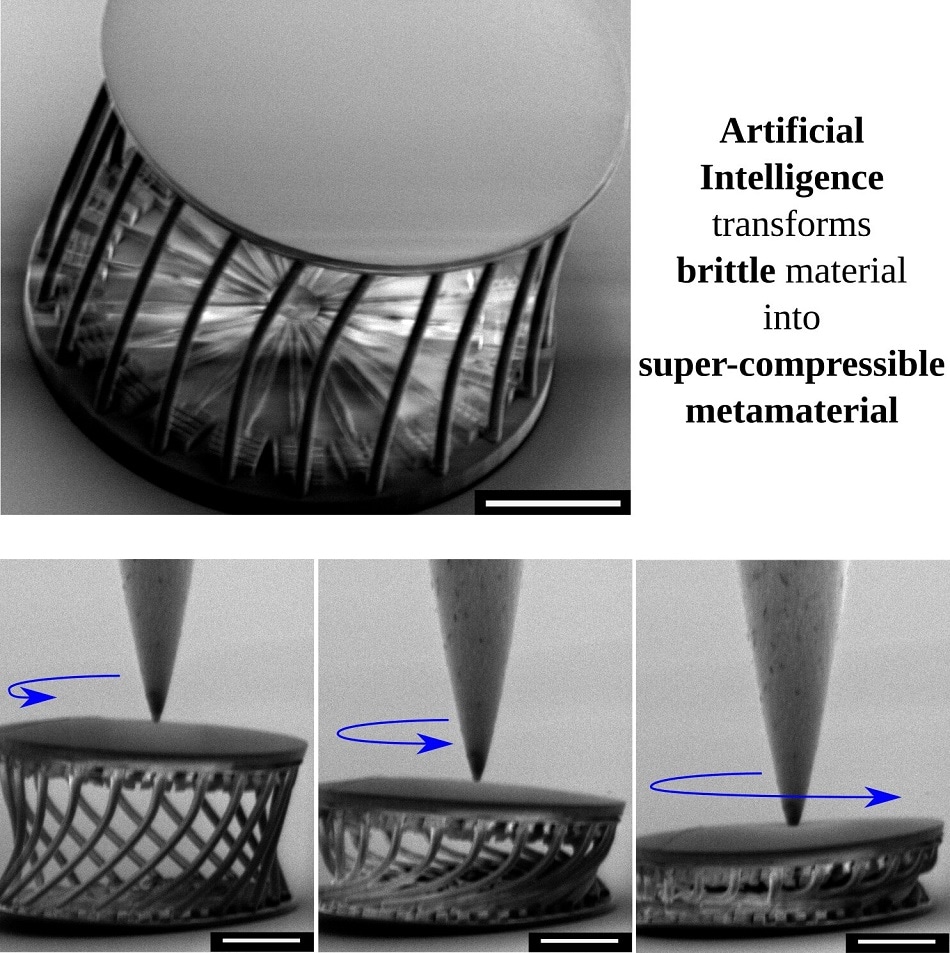 Metamaterial created with Artificial Intelligence that transforms a brittle material into a sponge-like material. Unlike a sponge, this metamaterial is stiff until a critical force is reached after which it becomes easily compressible. Image credit: Delft University of Technology
Metamaterial created with Artificial Intelligence that transforms a brittle material into a sponge-like material. Unlike a sponge, this metamaterial is stiff until a critical force is reached after which it becomes easily compressible. Image credit: Delft University of Technology
Researchers have proved that it is possible to design new materials using only artificial intelligence (AI), without the need for experimental tests. Experts believe that the use of AI and machine learning will open the door to creating the materials of the future.
A Shift In How Materials are Designed
Researchers at TU Delft have used AI to create a new material with impressive properties. The scientists have achieved a feat that may cause a shift in how new materials are designed, as they have successfully produced a new material without the need for physical experimental tests, only AI.
Everyday Objects You Can Fold Into Your Pocket
The inspiration for the new design method came to Miguel Bessa, who works at TU Delft as the assistant professor in materials science and engineering, when he began considering the satellite structure he noticed at the California Institute of Technology.
It could open long solar sails from out of a tiny package. This got him thinking about the possibility of creating a very strong material that could be compressible. He considered the idea of being able to design everyday objects that could be folded into your pocket, like a bicycle.
Bessa noted how the current method of metamaterial design relied heavily on long periods of experimentation, taking on a trial-and-error approach. In recognizing that this was not efficient, Bessa and his team looked to AI and machine learning in order to create a system that could design the materials of the future without the need for a lengthy testing process.
A paper published in Advanced Materials this October describes the method Bessa and his team took to create their new material. They used a computational data-driven approach which allowed them to model how different substrates could work to achieve different target properties. Using this method they were able to transform brittle polymers into flexible, super-compressible, lightweight materials.
Bessa sees this as a significant step towards the future of materials, which he believes will need to be adaptive, multi-purpose and tunable, and using his method, they will be achievable.
AI and Machine Learning Taking Over Materials Science
The team at TU Delft aren’t the only ones who have been working with AI and machine learning to create new materials. MIT has also been making progress in this field, and they consider it to be the future of materials science. A team at MIT has created a system using machine learning that enhances the performance of a chip-based spectrometer. They have also been able to build an artificial intelligence system that reads through scientific papers in order to understand the ‘recipes’ of certain materials.
Further to this, they’ve created a deep learning algorithm that can assess the workability of irregular shapes and screen out combinations of materials and functions that wouldn’t work.
Future Directions
The work that has come out of TU Delft is significant not particularly due to the material it was able to create, but because the new method of material design has the potential to unlock areas of the design space that are currently untapped. Machine learning opens the door to designing materials to a specific brief in a fraction of the time that conventional testing would allow.
It also allows for new and functional materials to be created. Bessa believes that data-driven science will be revolutionary in the mechanics and materials science space. Experts anticipate that this kind of material design will bring the creation of many new and exciting materials for applications in all industries, as machine learning will be able to deduce how to successfully create a material with the exact properties required.
Disclaimer: The views expressed here are those of the author expressed in their private capacity and do not necessarily represent the views of AZoM.com Limited T/A AZoNetwork the owner and operator of this website. This disclaimer forms part of the Terms and conditions of use of this website.